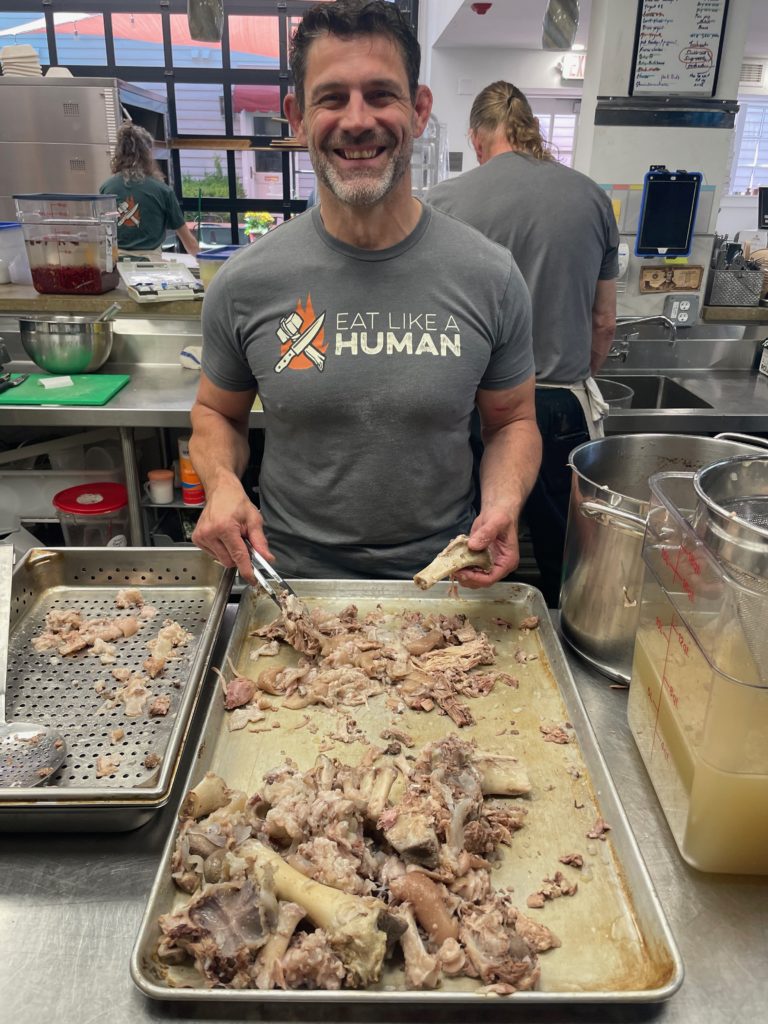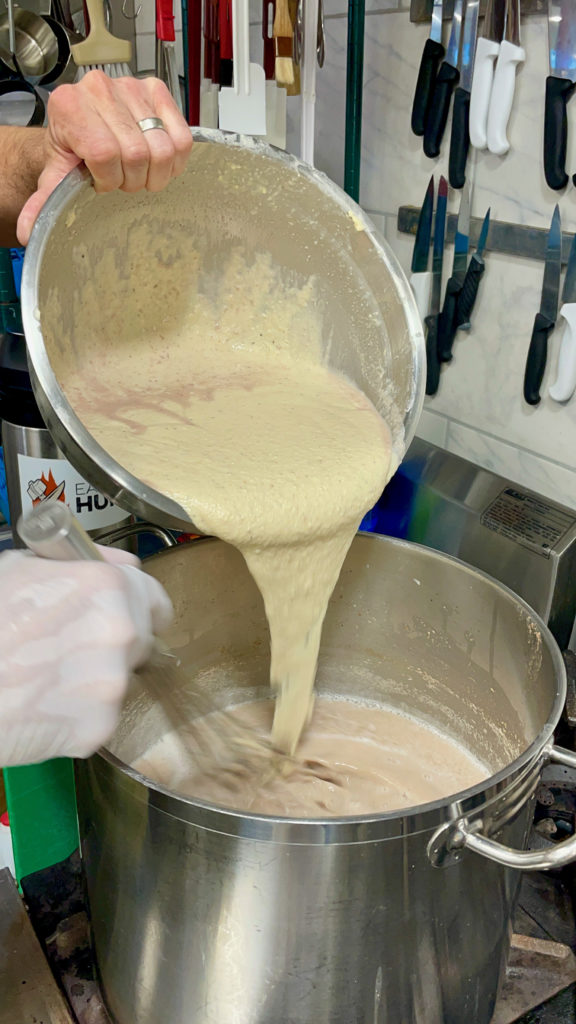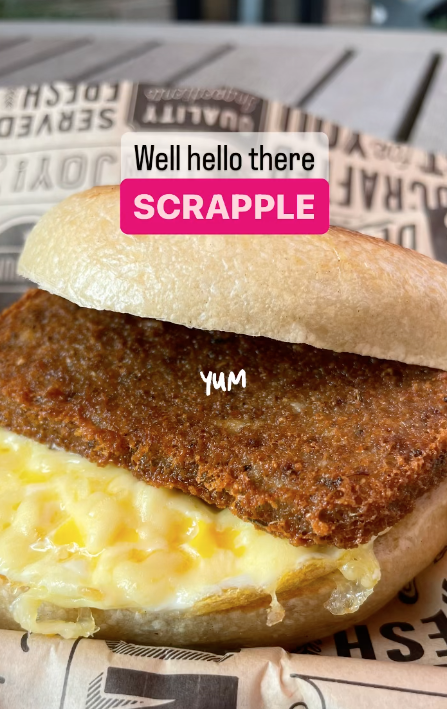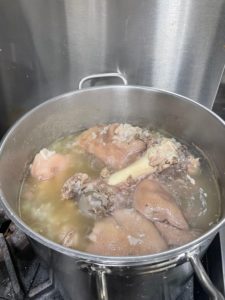Is scrapple healthy?
100% And, here’s why…
Don’t let the greenish gray color fool you.
Scrapple is literally a bone broth offal bomb and loaded with both flavor and nutrition!
How could it not be? It is made by simmering the head, trotters (feet), skin, bones and meat of a pig in a pot until tender while the bone marrow, bone grease, collagen, minerals, other nutrients and a TON of flavor all work together to create a nutrient rich the broth. The meat, skin, and connective tissues are removed, ground together with the organs and added back into the stock. Cereal grains for thickening, salt and a variety of other spices are added and the resulting mush is cooked until thick and poured into pans to cool. After cooling the loaves are cut into slices which are fried or baked until crispy.





Why have scrapple at the MSAK?
This celebrated traditional, breakfast comfort food from the Mid-Atlantic region is not only healthy, but epitomizes everything we stand for at the Modern Stone Age Kitchen. It is delicious, nourishing, ethical, sustainable and economical. Since the most traditional versions of scrapple rely heavily on organs, skin, feet and heads it is a genuine nose-to-tail, whole animal food. It is nutrient dense and, most importantly, bioavailable – which means the nutrients it contains are readily available to our human bodies. Scrapple is loaded with protein including tons of collagen, the primary building block of our body’s skin, muscles, bones, tendons, ligaments and other connective tissues. It also contains iron, zinc, selenium, B-complex vitamins and a host of other micronutrients. It is also delicious and, when cooked properly, has an irresistible texture that simultaneously consists of a crispy exterior and tender interior.
How did scrapple get its name?
In my attempt to learn everything I could about scrapple I enlisted the help of my favorite author, educator, researcher, and clinician, Dr. Tammera Karr. As usual, she was incredibly helpful and provided me with several historic references to scrapple including excerpts from the Oxford Companion to American Food and Drink in which Andrew Smith tackles the root of the name scrapple. Smith notes that well before the name scrapple (which didn’t appear in America until 1820) it was referred to by its Pennsylvania Dutch name, pannhaas (along with its various spellings: pawnhas, pawnhoss, panhas, and even pan hoss). Some researchers suggest these names derive from the Dutch word panhoss which literally means “pan tenderloin.” Others argue that instead they come from the German black pudding, panhas, or even have roots in the name of a Celtic vessel, panna, representing the loaf pan the mush is set to cool and form in. Foodrepublic.com believes it stems from, “the German word ‘panhaskröppe,’ a combination of the words “panaas” (pan rabbit) and “skröppel” (slice of)” which would explain the use of both the terms pannhaas and scrapple here in America. Most people believe strongly that the modern term, scrapple, simply refers to the English word scrap, which simply means kitchen leftovers.

Regardless of its etymology, the production of scrapple carries on the tradition of incorporating grains as a thickener from its earlier blood sausage roots. And, just like various European blood sausage variations which rely on different cereals like rice in Spanish morcilla, wheat in German panhas, oats in Irish black pudding and barley in British black pudding, different scrapples make use of the dominant grain of the region in which it is made. While cornmeal, rye, buckwheat and/or barley dominate in different areas of Pennsylvania, Delaware and Maryland, a variation of scrapple made in Ohio known as Goetta or Glier (depending on its shape) contains steel cut oats.
Where can it go wrong (and what to do about it)…
Although scrapple can be an amazing food, remember, all scrapples are not created equal. Just like practically all other foods in the modern world, the industrial food system machine has bastardized this incredible food and created an unhealthy, more economical version that is easier to produce and ships and stores longer. Keep a close eye out for scrapple that contains all sorts of fillers, stabilizers, emulsifiers, and preservatives. Since it is important to also know what your food ate, identifying and evaluating the source of the meat and offal that goes into scrapple is equally critical. And, the binder used to keep it all together can make all the difference. If you are gluten intolerant make sure your scrapple does not contain wheat or barley. Buckwheat, which is also often used as a thickening agent, is loaded with oxalates. And, remember, maize is one of the most difficult grains in the world for our human digestive tract to derive nutrition from so when cornmeal is used you can be assured some of the nutrition it contains is passing directly through you. And, no matter what cereal grain is used, it ALWAYS needs to be processed in some way to maximize its safety and bioavailability.
In addition to ensuring that your scrapple is as nourishing as it can be, it also needs to be cooked in a healthy way. Frying even the best of scrapples in industrial nut or seed oils is a sure way to make it unhealthy. To maximize the nourishing qualities of scrapple it needs to be cooked in traditional animal fats such as lard or butter.

(no industrial nut or seed oils of course)!
The Modern Stone Age Kitchen Scrapple
So, what makes our scrapple different?
First, we make sure to only use high quality, traditional ingredients. As a result there are no additives whatsoever. We also use only local, Kent County Langenfelter Pork, butchered in-house.
And, we make use of the entire animal!
The recipe we developed relies equally on one part meat and skin to one part organs and we create a collagen rich bone broth from the bones, feet, and head (when available) to ensure it is as nutrient dense as it can possibly be.
And, finally what makes our scrapple so very different is that we nixtamalize and stone ground organic, heirloom maize from Oaxaca to make the safest, most nutrient dense and bioavailable cereal grain thickening agent possible. This is much more nutritious than simply using cornmeal. And, yes, that means there is no gluten in our scrapple.
Is scrapple a “superfood?”
I hate the term “superfood” for a variety of important reasons. But, that is a topic for another blog post. However, since the term is such a common part of our modern vernacular then I will use it here. If the definition of a superfood is something that is safer, more nutrient dense and bioavailable than almost all other foods in our food system then our MSAK scrapple is definitely a superfood!







 What can pizza teach you?
What can pizza teach you? 
My family loves scrapple! Do you sell the scrapple you make?
Yes we do! Right now just on sandwiches but hoping to be able to offer it in our reach-in fridge soon!
What do you think of the theory that pork can be bad for you if it’s not marinated in vinegar? The Weston A Price Foundation believes this to be true. According to them it impacts the blood negatively.
I literally cannot wait for this to be available in the fridge. The scrapple egg n cheese croissant was too good.
We are working on it!! Thanks so much for letting us know